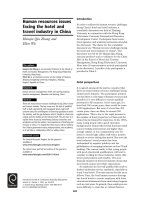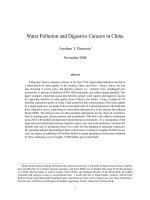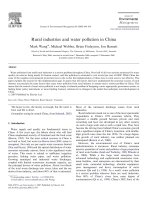Foreign investment and corporate governence in china
Bạn đang xem bản rút gọn của tài liệu. Xem và tải ngay bản đầy đủ của tài liệu tại đây (799.25 KB, 302 trang )
Foreign Investment and
Corporate Governance
in China
Yanni Yan
Foreign Investment and Corporate Governance in China
Also by Yanni Yan
INTERNATIONAL JOINT VENTURES IN CHINA
Foreign Investment and
Corporate Governance
in China
Yanni Yan
© Yanni Yan 2005
All rights reserved. No reproduction, copy or transmission of this
publication may be made without written permission.
No paragraph of this publication may be reproduced, copied or transmitted
save with written permission or in accordance with the provisions of the
Copyright, Designs and Patents Act 1988, or under the terms of any licence
permitting limited copying issued by the Copyright Licensing Agency,
90 Tottenham Court Road, London W1T 4LP.
Any person who does any unauthorized act in relation to this publication
may be liable to criminal prosecution and civil claims for damages.
The author has asserted her right to be identified
as the author of this work in accordance with the Copyright,
Designs and Patents Act 1988.
First published 2005 by
PALGRAVE MACMILLAN
Houndmills, Basingstoke, Hampshire RG21 6XS and
175 Fifth Avenue, New York, N.Y. 10010
Companies and representatives throughout the world
PALGRAVE MACMILLAN is the global academic imprint of the Palgrave
Macmillan division of St. Martin’s Press, LLC and of Palgrave Macmillan Ltd.
Macmillan® is a registered trademark in the United States, United Kingdom
and other countries. Palgrave is a registered trademark in the European
Union and other countries.
ISBN 1–4039–4362–1
This book is printed on paper suitable for recycling and made from fully
managed and sustained forest sources.
A catalogue record for this book is available from the British Library.
Library of Congress Cataloging-in-Publication Data
Yan, Yanni, 1958–
Foreign investment and corporate governance in China / Yanni Yan.
p. cm.
Includes bibliographical references and index.
ISBN 1–4039–4362–1
1. Investments, Foreign—China. 2. Corporate governance—China.
3. Corporate governance—Law and legislation—China. I. Title.
HG5782.Y33 2005
332.67′3′0951—dc22
2004052230
10
14
9
13
8
12
7
11
6
10
5
09
4
08
3
07
2
06
1
05
Printed and bound in Great Britain by
Antony Rowe Ltd, Chippenham and Eastbourne
Contents
List of Figures
ix
List of Tables
x
Preface
xi
Acknowledgements
xiv
List of Abbreviations
Part I
xvii
Foreign Investment in Transitional Economies
1 The Rise of the Transitional Economies
Introduction
Outlook of the transitional economies
Strategic profile of foreign investment
Economic profile of foreign investment
Socio-cultural profile of foreign investment
Foreign investment in the industrial sector
Geographical distribution of foreign investment
Overview of the Chinese domestic investment profile
Market entry modes of foreign investment
Principal issues identified
Plan of the book
Summary
2 Foreign Direct Investment
3
3
5
7
7
9
10
11
13
20
22
25
26
Introduction
The theory of foreign direct investment
Foreign investment and economic liberalization
The implications of opening Chinese markets
Summary
Part II
3
26
26
34
39
43
Building Blocks for Corporate Governance
3 Building Blocks for National Institutions
Introduction
Reform of national financing
53
53
54
v
vi Contents
Reform of political institutions
Reform of national taxation
Encouraging foreign investment firms
Summary
4 Building Blocks for Corporate Governance
58
65
69
73
74
Introduction
Theoretical perspectives on corporate governance
Corporate governance at the national level
Corporate governance at the organizational level
Summary
74
74
77
84
94
5 Research Undertaken into Foreign Investment and
Corporate Governance
95
Introduction
The formation model
The ownership investment model
The corporate governance model
The corporate culture model
The organizational learning model
Research measure construction
Pilot study
Interview procedure
Sampling
Choices of industrial sectors
Data collection
Coding
Summary
Part III
95
95
97
98
100
101
101
104
105
108
109
110
112
114
Managing an International Strategic Alliance
6 Forming an International Strategic Alliance
Introduction
Ownership determinants: resource-based theory
Ownership leverage: resource dependence theory
Ownership, localization and internalization theory
Developing a checklist for forming a strategic alliance
Strategic motives
The feasibility study
Summary
119
119
119
121
123
126
129
131
138
Contents vii
7 Ownership Investments and International
Technology Transfer
Introduction
Ownership configuration
International technology
Motivation for technology transfer
Process of technology transfer
Absorptive capacity and technology transfer
Technology transfer performance
Summary
8 Exercising the Strategic Role of the Board
and Management
Introduction
Strategic role of the board of directors
The strategic alliance’s management
Summary
9 Corporate Culture and an International Strategic
Alliance in Transition
Introduction
National cultural model
Management of corporate culture
Summary
10 Organizational Learning
Introduction
Learning conceptualization
Achieving learning advantages
Dynamic organizational learning
Determinants of organizational learning
Learning achieved throughout an alliance’s hierarchies
Summary
Part IV
142
142
142
150
153
155
158
160
162
163
163
163
175
184
185
185
185
189
208
209
209
209
210
216
220
224
229
Implications for Research and Practice
11 What We Still Need to Learn
Introduction
Performance conceptualization
Objective versus subjective performance measures
Strategic alliance formation
Ownership investments
Corporate governance
233
233
233
237
240
242
244
viii Contents
Corporate culture
Organizational learning
Building main themes for foreign investment and corporate
governance
Summary
245
246
249
252
Appendix I: Major Tax Payments for Foreign Firms in China
254
Appendix II: Interview Questionnaire for Forming an International
Strategic Alliance
260
References
269
Index
276
List of Figures
1.1
1.2
2.1
2.2
3.1
4.1
5.1
7.1
8.1
8.2
9.1
9.2
10.1
10.2
10.3
Strategic investment profile in China
Foreign investments and corporate governance
The strategic importance of the influence of
governance and economic liberalization in China
An overview of foreign investments in China
Building blocks for national institutions in China
‘New diamond’ of corporate governance in
an international strategic alliance
Research undertaken for foreign investment
and corporate governance
International technology transfer in an international
strategic alliance
Governance field analyses of international
strategic alliances
A general model of resource provision, key appointments
and management of an international strategic alliance
Exercising cultural attributes in an international
strategic alliance
Management of corporate culture in an international
strategic alliance
Organizational learning in an international
strategic alliance
Determinants of organizational learning
Learning successes affected by an international
strategic alliance’s hierarchies
ix
14
23
35
41
54
77
113
153
164
174
187
191
211
221
225
List of Tables
2.1
2.2
3.1
4.1
6.1
6.2
6.3
6.4
7.1
7.2
8.1
9.1
9.2
9.3
10.1
10.2
10.3
11.1
Theoretical contributions on foreign direct investment
FDI policies in China and their outcomes
Summary of some research evidence pointing to
a host country’s political institutions
Theoretical contributions to corporate governance
Ownership advantages for forming an international
strategic alliance
Ranking partners’ strategic motives
Application for the establishment of an international
strategic alliance
A checklist for the feasibility study: searching out relevant
information for an international strategic alliance
Theoretical contributions to the ownership configuration
of an international strategic alliance
Identification of the primary technological activities
that affect the performance of technology transfer
Influence exercised over different areas and
management issues by local and foreign parent firms
Long-term strategic orientation versus pragmatic
business orientation on finance aspects displayed
by an international strategic alliance
Adoption of human resource management practices
in an international strategic alliance
Management of corporate culture in an international
strategic alliance
Main learning experiences gained in a strategic alliance
T-test for the learning outcomes achieved in
an international strategic alliance over operational,
system and strategic levels
Main features of organizational learning in
an international strategic alliance
Five indicators for a research framework for the
relationship between the foreign investments and
corporate governance
x
27
44
63
78
125
130
139
140
151
161
183
190
202
205
216
224
228
249
Preface
This book reports on foreign investments in transitional economies
and the corporate governance of international strategic alliances in China.
Foreign investments in China have caused a remarkable shift in the
competitiveness of its economy to the extent that it has dramatically
increased exports of labour intensive products. The long-standing central
issues of FDI in transitional economies have added new dimensions to
conventional Western management practice and highlighted new
relationships that must be considered when choosing the right form of
market entry strategy. Corporate governance, namely the relationship
between the ownership and control of firms, takes on new dimensions
in the case of international strategic alliances operating in the special
context of China. The book contributes an insightful examination of
foreign investment in transitional economics and its strategic roles
played in international business. Key findings provide implications for
understanding strategic, managerial and operational matters.
The book is intended to offer new academic perspectives and insights
to illustrate corporate investment in transitional economies. This book
discusses the dichotomies faced by most international firms that include:
whether to tightly integrate international investment to the implementation of their own strategic and financial control or to relinquish equity
authority to host country managers; whether market orientation should
be dependent mainly upon non-equity based investments using an international branding approach or should be more focused on local market
conditions; whether ongoing development of organizational culture,
learning and corporate governance should strictly adhere to corporate
standards or be developed with local conditions in mind. In a transitional
economy, the foreign investments pursued through international strategic alliances create great challenges for the host government.
This book throws new light on the foreign investment process and
provides an overview of corporate governance in China. It draws on
investigations into over a thousand international strategic alliances. The
creation of a sound market environment requires primarily an understanding of how a host country’s economic, socio-cultural and political
institutions influence a firm’s governance. Such influence is believed to
affect the competitiveness of the national economy as it dictates how
xi
xii Preface
strategic alliances can be run more effectively within a given society.
The book draws important conclusions for theory and practice on the
basis of original empirical research conducted with the co-operation of
strategic alliance managers. The construction of market environments
that facilitate the effective use of a host country’s overall investments is
essential. It appears that western theory can usefully be applied to
China, despite the contextual differences.
The book examines FDI in transition economies and develops the
conceptual and theoretical basis of the significant research that has
been undertaken. Because of FDI policy work with nationa1 and international organizations, this book is able to offer a first-hand perspective
of corporate governance activities in international strategic alliances.
As a result, this book lays the foundation for an understanding of the
rise of transition economies through the explanation of overall patterns
of international trade and the role that China plays in international
business, especially as a host for foreign investment.
This book not only offers a strong theory base on building blocks for
corporate governance but also fully reflects the managerial concerns of
those who work on the frontline in the business world. The assessment
and management of foreign investment is an integral element of a firm’s
corporate governance. The corporate governance of an international
strategic alliance in China may involve different forms of political
patronage, privileged access to markets, or development opportunities.
This book offers the perspective of the corporate governance in international strategic alliances. In-depth attention is paid to the role of FDI,
cultural issues, corporate governance and organizational learning. It
provides a good understanding on how and why governments intervene
in markets and suggests alternatives for working with governments to
achieve corporate goals. The book also addresses key issues associated
with the management of foreign investments. Achievement of an optimal
balance of foreign investment inputs and the associated corporate
governance in an international strategic alliance is bound to be dependent
upon the local investment conditions and technical requirements.
Applying a research framework on international strategic alliance to
formation, foreign investment, corporate governance, organizational
culture and learning has derived key findings and implications. Specific
experiences in international strategic alliances have stimulated research
and discussion into a number of issues of wider interest to international
business. The research evidence shows that China’s economy is developing rapidly with the assistance of considerable diversification in the
sources and destinations of investment. The political and economic
Preface xiii
evidence in China on increases in foreign trade, international investment
and international production have generated significant attention from
researchers who wish to examine the subsequent effects on FDI and
foreign trade flows.
YANNI YAN
Acknowledgements
First and foremost I wish to express my appreciation to those individuals,
companies and employers who have made significant commitments
of time, effort and financial resources. I am most grateful for their
dedication, support and assistance in helping me in my endeavours to
complete the book. This study has benefited significantly from the
encouragement and support generously given by my colleagues in the
Marketing Department of the City University of Hong Kong. I would
like to thank all of them sincerely.
I must acknowledge the valuable collaboration of a large number of
international strategic alliances in China who have had the courage
to air their foreign investment decisions and corporate governance
publicly. In preparing this book, I have been significantly assisted by
many strategic alliances and their managers who have provided me
with many examples. My thanks go to the numerous expatriates and
Chinese managers of these international strategic alliances in China
who have provided the data on which this study is based. Without their
co-operation, there would have been no research findings to report. The
areas of foreign investments and corporate governance in international
strategic alliances have long intrigued me as I am deeply impressed by
the investment strategies that are formulated and the efficiency of the
alliances’ corporate governance. Throughout this book, I have made
reference to what I have learned from managers during the interviews I
conducted. This book not only provides readers with a strong pragmatic
base but also fully reflects the managerial concerns of those who work
on the front line.
Colleagues in the China project team contributed ideas about international strategic alliances and their fieldwork methods, as well as assisting
with access to such alliances. My deep gratitude goes to Professor John
Child, who has given me continuous guidance and support throughout
the four years that I have worked in Hong Kong. The final writing of this
book gained a great deal from support generously given by Professor
Yang Shu Quan from the Ministry of Electronics, and Shirley Yeung,
my research assistant, who has worked diligently with me at the City
University of Hong Kong after successfully completing her BA in Chinese
xiv
Acknowledgements xv
Business. She brought great insight to research projects and continues
to engage in stimulating discussion with me on the subject.
I would like to express my thanks to my current employer for allowing
me the time to complete this book. The City University of Hong Kong
has been most generous in its research grants in support of all my
research activities. I have also benefited from opportunities to pursue
research for the book sponsored by a competitive earmarked research
grant (a grant from the Hong Kong government), a direct allocation
grant (a grant from the City University), and a strategic research grant
(also from the City University). I have been fortunate to receive eight
research project awards over four years resulting in grants of more than
HK$1.5 million which has definitely enhanced my general understanding of the subject of foreign direct investment, corporate governance,
corporate culture and organizational learning within international
strategic alliances. I am also very grateful to various institutions including
the Research Grant Committee of the Hong Kong Government for their
sponsorship of this study. United Distillers Asia Pacific, Rothmans
Charitable Trust, the School of Business at Hong Kong University,
Churchill College and Cambridge University have all provided further
funds to cover research costs and conference travel.
Within the university community, I have been fortunate to work with
a series of postgraduate students who have become research assistants.
I wish to thank those students at the City University of Hong Kong,
members of the City University Executive Master of Business Administration (EMBA) in the Management of International Joint Venture courses
of 2000 and 2002, the Hong Kong Polytechnic University’s Doctor of
Business Administration (DBA) in Management of International Joint
Venture courses of 2001 and 2002, and undergraduate students for the
Chinese Multinational course 2004 who have let me try my new material
on them. My colleagues are thanked for their constant insights and
contributions in the departmental seminars that have helped me to
develop my own ideas and have provided valuable comments on an
earlier draft of the book. Both undergraduates and postgraduates have
generously supplied an untold number of insightful comments and
helpful suggestions.
A number of people have assisted in bringing this book to print.
I appreciate the encouragement and support received from Dr John
Richard Fawn who has been a constant source of assistance and advice
throughout the publishing process. Dr Fawn has contributed in many
ways to this book through his insights in discussions and I have benefited greatly from his help during the evolution of this book. My thanks
xvi Acknowledgements
also go out to Keith Povey, the book editor, and Jacky Kippenberger, the
editor of Palgrave Macmillan; they offered considerable help in directing my efforts in the book. In addition, I give special thanks to Geff
Heathman, Shirley Hockins and Easther Lam for their helpful suggestions. Last but not least, I could not have completed the task without the
forbearance and sympathetic support of my family. During the time in
which this book has taken shape, I have been the fortunate beneficiary of
constant support from my family, especially the love and encouragement
of my parents, Gongxin Yan and Liqin Lin. My brother, Keguo Yan,
sister, Mingxia Yan, and uncle, Professor Gongbiao Yan, also gave their
encouragement. In particular, Rungang Zhang, my husband, and Zichao
Zhang, our son, have demonstrated their patience, tolerance, and above
all love throughout my studies in Birmingham, Cambridge, Essex and
at the City University of Hong Kong.
List of Abbreviations
CJV
EJV
FDI
GDP
H–O
HRM
IJVs
OLI
PLC
R&D
SEZs
SOEs
WOS
WTO
co-operative joint venture
equity joint venture
foreign direct investment
gross domestic product
Heckscher–Ohlin
human resources management
international joint ventures
ownership, location, internalization
product life cycle
research and development
special economic zones
state-owned enterprises
wholly-owned subsidiary
World Trade Organization
xvii
This page intentionally left blank
Part I
Foreign Investment in Transitional
Economies
This page intentionally left blank
1
The Rise of the Transitional Economies
Introduction
This chapter presents an overall view on available market entry strategies,
organizational configurations and the alternative methods by which
firms may structure their international investment and international
production in foreign countries. It has become increasingly important
for business practitioners and researchers to examine the trends in
foreign direct investment (FDI) in China. Although the World Trade
Organization (WTO) indicates that major foreign investments have successfully changed key economic indicators in transitional economies,
most foreign firms in China still find it a challenge to select an effective
market entry strategy for an international investment in production
facilities. This chapter identifies the principal issues and outlines the
content of the book.
Outlook of the transitional economies
The process of structuring foreign investments in transitional economies
in a way that will satisfy market demands and the overall strategic
objective of achieving a more efficient global trading system based upon
international investment and production is complex. The scale of FDI
ultimately defines the types of advanced technology, product innovation
and international management created in a given country. Foreign
investments in China have caused a dramatic shift in the competitiveness of other national economies to the extent that they have increased
China’s exports of labour-intensive products and taken market share
from companies with a higher labour cost base. The emerging Chinese
3
4 Foreign Investment in Transitional Economies
market economy has also developed its industries in areas where more
technology-intensive production methods can be combined with lower
labour costs. The long-standing central issues of foreign investment in
transitional economies have added new dimensions to the conventional
Western investment approach by introducing new relationships for
evaluation when choosing the most appropriate form of market entry
strategy, ownership resources, corporate governance, corporate culture and
organizational learning. Issues of particular importance to transitional
economies are discussed with respect to their possible primacy on FDI
policies in countries such as China.
As an illustration of foreign investment in transitional economies, this
chapter presents the dichotomies faced by most foreign firms in China,
which include strategic issues such as technological intensity, investment
location and ownership arrangements. The writer provides a detailed
discussion as to whether to tightly link international investment and
international production with the implementation of foreign firms’
strategic and financial control or relinquish their equity authority to
a host country’s managers; whether market orientation should be
dependent mainly upon foreign firms’ non-equity based investments
through the use of an international branding approach or more focused
on local market conditions; whether on-going development of foreign
firms’ corporate culture, organizational learning and corporate governance
should strictly adhere to Western management standards or should be
developed with local conditions in mind.
Host governments in transitional economy countries may wish local
firms to maintain some control over their subsidiaries even if these local
firms are not in a financial position to contribute the majority of equity
capital. Their strategic rationales are to minimize possible exploitation
by powerful foreign firms through the manipulation of controls on
technology transfer whilst encouraging local participation in joint equity
ownership such as international joint ventures (IJVs) in a form that
facilitates international technology transfer. One of the primary driving
forces behind the long-term upturn in the Chinese economy is the dramatic increase in the growth of foreign investment, the transformation
of the technology base, potential market demand and business internationalization. The more upbeat current economic forecasts suggest
that China is ranked as the top FDI recipient amongst the developing
countries and has the highest ranked current overall gross domestic
product (GDP) growth rates in the world. China has continuously
achieved an average growth rate of 8 per cent for three decades. There are
strong indications that the increasing rate of FDI in China is due to the
The Rise of the Transitional Economies 5
government’s economic policy which prioritizes expansion of its domestic
market demand. China’s economic growth is also dependent upon
economic liberalization based upon overall industrial development. Thus
the increase in foreign investments in China reflects not only domestic
market demand, but also an overall industrial ability to meet the needs
of primary international markets.
Strategic profile of foreign investment
China is the largest host country for FDI amongst developing countries
and provides an important venue for the study of market entry strategies
from both a theoretical and practical perspective. With a long-standing
and unique cultural tradition, China is still a nominally socialist country
whose government plays an active role in business affairs. Central government intervention, infrastructure changes, specific targeted plans for
political institution development, technology transformation and economic liberalization are mainly used to justify government authority
and the formal right to manage the economy. The diversity of overall
trade development allows a multifaceted analysis that sheds significant
light on how the Chinese economy performs. There is no doubt, however,
that the Chinese economy has been able to benefit from its improved
international competitive position, which in turn has primarily been
derived from its economic transformation based upon FDI-led increases
in foreign trade.
Increases in FDI have raised significant concerns within China about
heightened market competition from international businesses which
now dominate certain industrial sectors with highly profitable operations
in China at the expense of some domestic firms which used to service
provincial markets. Some foreign firms have found that the provision of
local capacity in specific industrial sectors establishes the opportunity
for market expansion throughout broader-based Chinese nationwide
markets. There are growing numbers of international strategic alliances
in China where equity joint ventures and co-operative ventures are
fully capable of managing exogenous factors which can impact business
performance achievement, such as quality of local resources, labour, the
supply of components and administrative intervention by the central
government. Despite the overall positive FDI environment established
in China, government attention still needs to be directed towards the
reforms necessary in its political institutions and economic infrastructure.
The formal propaganda that concentrates on the positive indicators of
6 Foreign Investment in Transitional Economies
China’s economic growth shows that the government may be complacent
in its attitude towards the formulation and implementation of economic
reforms, including FDI policies.
China has been able to capitalize on its improved economic competitiveness only when its economic and political reforms are properly
codified. FDI flows are positively influenced by increasing the level of
certainty affecting those strategic factors that determine a host country’s
market performance, especially if they ensure that superior performance
from better-quality high-technology operations is available in a transparent and predictable political and legal environment. For example, the
establishment of IJV bankruptcy laws and the operational procedures that
provide a legal framework for an IJV’s management functions are essential prerequisites, including areas such as the appointment of the board
of directors, the requirements for accounts to be drawn up according to
international conventions, and international auditing procedures and
operational regulations. The regulations, procedures and policies relating
to foreign investments that were introduced encouraged foreign firms
to generate more investments and increased the rate of establishment
of international strategic alliances in China. This new regulatory framework was accompanied by specific short-term regional tax benefit policies
that provided incentives for targeted FDI activities.
The Chinese government pursues a macroeconomic policy that includes
an emphasis on maintaining steady economic growth with low inflation
and a stable currency. Whilst evaluating the effectiveness of a strategic
profile on overall foreign investments in China, attention has been generally focused on the goodness of fit between foreign firms’ resources,
knowledge and capabilities and the relevant control priorities they
adopted to achieve effective market entry. The management of foreign
investments in a transitional economy poses even greater challenges in
the proper exploitation of strategic benefits which can accrue from FDI
consistent with the determinants of foreign firms’ investment profile
and the level of control achieved over their intellectual property rights.
Increasing economic activity in international production and foreign
trade has driven Chinese markets to become more transparent, particularly in sectors that have opened up as WTO agreements have been
successfully implemented. With China’s accession to the WTO, foreign
capital, advanced technology and international management have
increasingly flowed into the country to take advantage of the lower cost
production activities that are a result of low labour costs and cheap
component resources.









